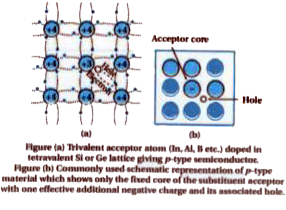What is p-type semiconductor? Name the majority and minority carriers in it. Solution in Gujrati
When a crystal of Si or Ge is formed, the trivalent atoms such as Al, B, In etc. are doped with small quantities in it, then the impurity atom is arranged in place of Si or Ge atom and the four Si or Ge atoms around it form a covalent bond with three atoms but fourth bond has an electron deficiency (absence or empty space), so that the hole is obtained, which is outlined in figure (a) and (b).

Since the holes has the property of attracting electrons, so the electron jump from nearest (neighbour) covalent bond in the crystal fills the hole so that the hole from which the electron is gone is now produced hole. Hence the p-type semiconductor gets a hole for conduction.
The trivalent foreign atom becomes effectively negatively charged when it shares fourth electron with neighbouring atom. Therefore, the dopant atom can be treated as core of a negative charge along with its associated hole as shown in figure (b).
Hence, one acceptor atom gives one hole. The total number of holes in the crystal is obtained in two ways. One from the number of impurity atoms which is much higher and second the release of electron from the bond of intrinsic semiconductors at room temperature creates hole whose number is very small.
Hence, in p-type semiconductor majority charge carriers is hole and minority charge carrier is electron.
The charge on hole is considered to be positive. From first letter of the word positive. This semiconductor is called p-type semiconductor.
For p-type semiconductor
where number of free electrons
number of hole
n-type or p-type semiconductor are electrically neutral. Because the charge of hole is the same as the charge (negative) at core of ionised atom and the opposite (positive) charge. Hence, charge on hole is positive. From first letter of the english word positive. This semiconductor is called p-type semiconductor.
Topper's Solved these Questions
- SEMICONDUCTOR ELECTRONICS : MATERIALS, DEVICES AND SIMPLE CIRCUITS BOOK - KUMAR PRAKASHANCHAPTER - SEMICONDUCTOR ELECTRONICS : MATERIALS, DEVICES AND SIMPLE CIRCUITS EXERCISE - Section-B : Numericals (Numerical From Textual illustrations)
16 Videos
- SEMICONDUCTOR ELECTRONICS : MATERIALS, DEVICES AND SIMPLE CIRCUITS BOOK - KUMAR PRAKASHANCHAPTER - SEMICONDUCTOR ELECTRONICS : MATERIALS, DEVICES AND SIMPLE CIRCUITS EXERCISE - Section-B : Numericals (Numerical From Textual Exercise)
15 Videos
- SEMICONDUCTOR ELECTRONICS : MATERIALS, DEVICES AND SIMPLE CIRCUITS BOOK - KUMAR PRAKASHANCHAPTER - SEMICONDUCTOR ELECTRONICS : MATERIALS, DEVICES AND SIMPLE CIRCUITS EXERCISE - Section-D : Multiple Choice Questions (MCQs) (MCQs asked in Competitive Exams)
129 Videos
- SAMPLE QUESTION PAPER BOOK - KUMAR PRAKASHANCHAPTER - SAMPLE QUESTION PAPER EXERCISE - PART-B SECTION-C
5 Videos
- WAVE OPTICSBOOK - KUMAR PRAKASHANCHAPTER - WAVE OPTICSEXERCISE - SECTION-D (MULTIPLCE CHOICE QUESTIONS (MCQS)) (MCQS FROM DARPAN BASED ON TEXTBOOK)
239 Videos
Similar Questions
C, Si and Ge have same lattice structure. Why is C insulator while Si and Ge intrinsic semiconductors?
View SolutionIn an n type silicon, which of the following statements is true:
View SolutionAt absolute zero temperature Si acts as ……..
View SolutionTwo charges –q and +q are located at points (0, 0, –a) and (0, 0, a), respectively.
(a) What is the electrostatic potential at the points (0, 0, z) and (x, y, 0) ?
(b) Obtain the dependence of potential on the distance r of a point from the origin when r/a>>1 .
(c) How much work is done in moving a small test charge from the point (5,0,0) to (–7,0,0) along the x-axis? Does the answer change if the path of the test charge between the same points is not along the x-axis?
View SolutionAccording to particle theory of light what is the velocity of light in a dense medium, compared to that in rare medium ?
View Solutionn - प्रकार के अर्द्धचालक में बहुसंख्यक तथा अल्पसंख्यक धारा-वाहकों के नाम लिखिए।
View Solutionp - टाइप के अर्द्धचालक में बहुसंख्यक तथा अल्पसंख्यक आवेश वाहकों के नाम लिखिये ।
View SolutionWhat is an n-type semiconductor ? What are the majority and minority charge carriers in it?
View SolutionWhat is a p-type semiconductor ? What are the majority and minority and minority charge carriers in it ?
View SolutionP- प्रकार के अर्धचालक और N- प्रकार के अर्धचालक में बहुसंख्यक आवेश वाहकों के नाम लिखिए।
View SolutionName the majority charge carriers in P-type semiconductors.
View SolutionWht are the majority and minority carriers in a p-type semiconductor?
View SolutionMinority carriers in a p-type semiconductor are
View SolutionWhat are the majority and minority charge carriers in a p type semiconductor
View SolutionWhat is n-type semiconductor? Name the majority and minority carriers in it.
View SolutionWhat is p-type semiconductor? Name the majority and minority carriers in it.
View Solution
